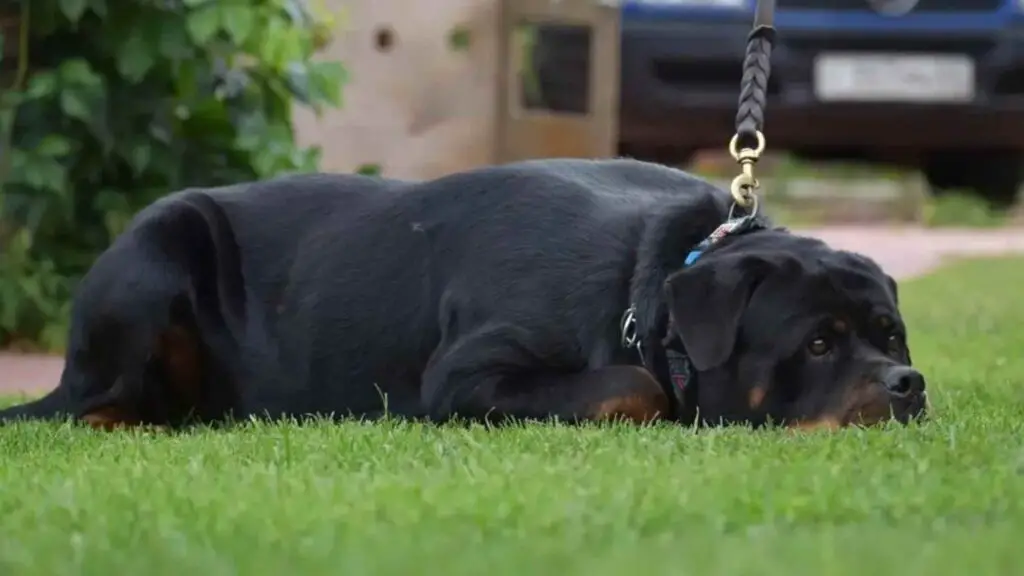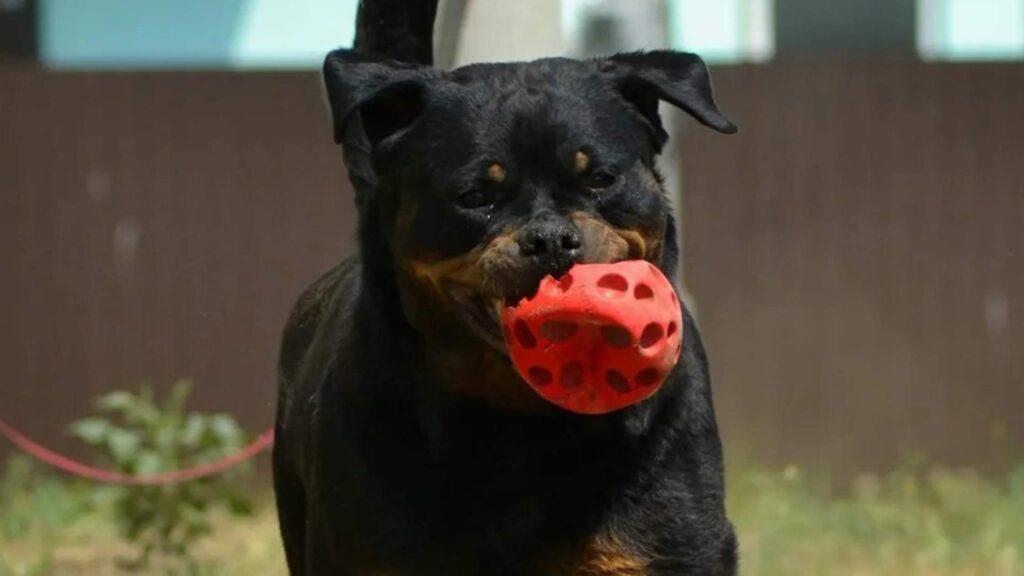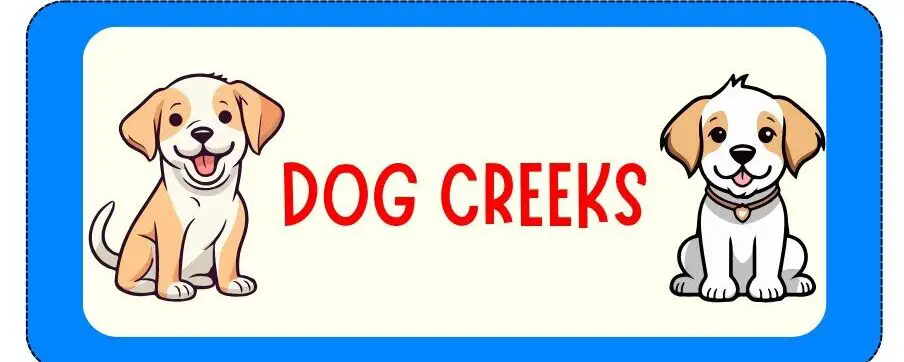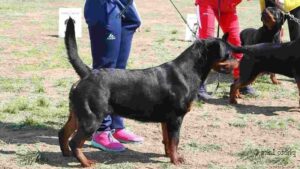As a long-time dog owner, I will discuss the signs your dog is bored based on my experience living with dogs.
In my experience living with dogs, I can tell you that there are lots of signs your dog will show you when they get bored.
If you ignore these signs, I can assure you that you will have a very destructive dog that will chew up your valuable items while you are away.
That being said, let’s quickly look at these signs…
Signs Your Dog Is Bored
Based on my experience living with dogs, here are some common signs your dog is bored:
1. Excessive chewing on inappropriate items
We all know dogs love to chew, but when they start gnawing on your favorite pair of shoes or the living room remote, it’s a sign that they’re bored.
On several occasions, I have met my Rottweiler chewing on my door because I failed to return home earlier than usual, and this is because she got bored and tired of waiting for me.
So, how can you identify this behavior:
To identify this behavior, based on my experience, I strongly advise you to keep an eye out for chewed-up belongings scattered around the house when you return home.
If your pup’s teeth marks are everywhere, it’s time to take action because if you allow it to continue, one day your house will be turned into a mess.
My recommendation:
First things first, I strongly recommend you provide your dog with appropriate chew toys and bones.
Not only will this redirect their chewing behavior, but it will also keep their dental health in check.
You should also engage in interactive playtime with your pup regularly to stimulate their mind and burn off excess energy.
Also, I suggest you provide puzzle toys and treat-dispensing toys, as these are also great options to keep them entertained. Remember, a tired dog is a happy dog!
2. Excessive scratching of carpets and furniture

If your pup has turned your living room into a scratching post, it’s a sure sign of boredom, and you shouldn’t ignore this behavior.
But how can you tell if it’s more than just an occasional itch?
To identify this behavior, I suggest you look for visible damage to your carpets and furniture, as well as your dog’s constant need to scratch and paw at these surfaces.
My recommendation:
One way to address this behavior in my opinion is by providing your dog with a designated scratching post or mat.
You should encourage them to use it through positive reinforcement and rewards, such as treats or praise.
You should also provide regular exercise and mental stimulation which are crucial for preventing boredom-related scratching.
I suggest you should also take your dog for walks, play fetch, or engage in interactive training sessions before leaving them alone.
Keep in mind that, a tired dog will be less likely to take out their energy on your furniture!
3. Excessive digging of holes in the yard
Is your backyard starting to resemble a mini construction site?
In my opinion, excessive digging is a clear indication that your dog is bored and looking for something to do.
Keep an eye out for freshly dug holes and scattered dirt around your yard.
My opinion:
In my opinion, to address this behavior, you should provide your dog with a dedicated digging area in the yard.
Fill it with sand or soft soil and bury toys or treats for them to discover, this will redirect their digging instinct to an appropriate spot.
Regular exercise, both physical and mental, is crucial to keep your pup engaged and entertained.
You should also consider introducing new toys and games to keep their minds stimulated and their paws out of the dirt.
4. Constantly escaping or trying to escape
Does your pup have a knack for adventure and constantly tries to escape? This could be a sign of boredom.
I advise you to keep an eye out for persistent attempts to run away or a strong desire to explore beyond their usual boundaries.
My suggestion:
To address this behavior, I suggest you constantly provide mental and physical stimulation for your dog.
You should also provide regular exercise, such as walks or playtime at the park, which can help burn off excess energy.
Engaging your dog in interactive games like fetch or training sessions can also provide the mental challenge they need.
Ensure your pup has plenty of toys to keep them occupied, especially puzzle toys that require problem-solving skills.
Additionally, you should consider creating a safe and secure outdoor space where they can explore and satisfy their natural curiosity.
5. Over-excitement and over-the-top greetings when you return home

We all love being greeted by an excited furry friend, but if your dog’s greetings are over-the-top and full of excessive excitement, it could be a sign of boredom.
Watch out for jumping, barking, or inability to calm down when you arrive home.
My opinion:
To address this behavior, I recommend you establish a calm and consistent routine.
You should encourage your dog to practice self-control by teaching them commands like “sit” or “stay” when you come through the door.
You should also engage in structured playtime, where you control your dog’s level of excitement.
I suggest you provide mental stimulation through puzzle toys or interactive feeding games to keep their minds engaged.
Remember, rewarding calm behavior and ignoring or redirecting excessive excitement will help teach your pup to greet you in a more balanced manner.
6. Excessive licking of themselves or you
If your dog is constantly licking themselves or even you, it may be a sign of boredom or anxiety.
I suggest you look out for persistent licking, especially in specific areas or when they seek attention.
My thoughts:
To address excessive licking, I advise you to rule out any underlying medical issues by consulting with a veterinarian.
If boredom is the primary cause, provide your dog with plenty of mental and physical stimulation.
You should engage in interactive playtime and exercise to burn off excess energy.
Offer a variety of chew toys to redirect their licking behavior. Additionally, consider using interactive treat-dispensing toys or frozen treats to keep them occupied.
If the licking persists, a professional trainer or behaviorist can provide additional guidance and support.
7. Unusual restlessness
If your normally calm and relaxed pooch starts displaying restlessness, it could be a sign of boredom and should not be ignored.
How can you identify this behavior?
I suggest you look out for excessive pacing, inability to settle down, or a constant need to move around without any apparent reason.
My suggestion:
To address restlessness, it’s important to provide mental and physical stimulation.
You should engage in interactive play sessions with toys, take your dog for daily walks or runs, and consider introducing puzzle toys or treat-dispensing toys to keep their minds occupied.
I also suggest regular exercise and training sessions can help burn off excess energy, leading to a more content and settled dog.
8. Running in circles or chasing their tail
We’ve all seen our dogs engage in a little tail-chasing fun, but when it becomes a frequent or obsessive behavior, it may be a sign of boredom.
So you should keep an eye out for your pup constantly running in circles or becoming fixated on their tail as this behavior can be a sign of boredom.
How to address this behavior:
To address this behavior, I suggest you try redirecting their attention to more mentally stimulating activities.
You should also provide puzzle toys that require problem-solving or interactive games that can help keep them engaged and distracted from chasing their tail.
I also recommend regular exercise is essential, as it helps release pent-up energy and reduces the likelihood of obsessive behaviors.
9. Following you around seeking attention
While it’s adorable to have a furry shadow, if your dog is constantly following you around and seeking attention, it may be a sign of boredom.
They’re looking for stimulation and interaction to alleviate their boredom, so you should always pay attention to this behavior.
My recommendation:
To address this behavior, I recommend you make sure your pup has plenty of activities to keep them occupied throughout the day.
Make sure you offer a variety of toys that challenge their problem-solving skills or engage their senses.
You should also enrich their environment with different scents, textures, and sounds.
Additionally, set aside dedicated playtime each day to give them the attention and interaction they crave.
Incorporate training exercises during playtime to mentally stimulate them and strengthen your bond.
Read more about the signs your dog is spoiled.
Effective ways of keeping your dog from getting bored

In my opinion, here are some effective strategies that will keep your dog entertained and engaged:
1. Interactive Toys: Invest in toys that can keep your dog mentally stimulated. Puzzle toys that require your dog to figure out how to get treats or toys from the inside can be a great option. These toys engage their problem-solving skills and keep their minds active.
2. Regular Exercise: A tired dog is a happy dog. Make sure to provide your pup with regular exercise to burn off excess energy. Long walks, runs, or trips to the dog park are great ways to keep them physically engaged and prevent boredom.
3. Playdates: Dogs are social creatures, so setting up playdates with other friendly dogs can be a fantastic way to keep them entertained. They can burn off energy, play games, and engage in social interactions, which are important for their mental well-being.
4. Obedience Training: Training sessions not only help your dog learn essential commands but also provide mental stimulation. Teach them new tricks or work on reinforcing existing commands. This not only keeps their minds engaged but also strengthens the bond between you and your pup.
5. Rotating Toys: Dogs can get bored with the same toys over time. To keep things interesting, rotate their toys every few days or weeks. This way, they’ll have something new and exciting to play with, preventing monotony.
6. Food Dispensing Toys: Instead of feeding your dog from a regular bowl, use food dispensing toys. These toys require your dog to work for their food, providing mental stimulation and entertainment. It’s a win-win situation!
7. Quality Time: Dogs thrive on human interaction and love spending time with their owners. Set aside dedicated playtime each day to engage in interactive games like fetch, tug-of-war, or hide-and-seek. This not only keeps them entertained but also strengthens your bond.
Read more about common behavior problems in dogs.
Final Thoughts
In summary, recognizing the signs that your dog is bored is crucial for their overall well-being.
Keep an eye out for behaviors like excessive chewing, restlessness, and seeking attention.
By providing mental stimulation, interactive toys, and regular exercise, you can ensure a happy and fulfilled furry friend.
Remember, a bored dog is a sad dog, so let’s make playtime a priority!









